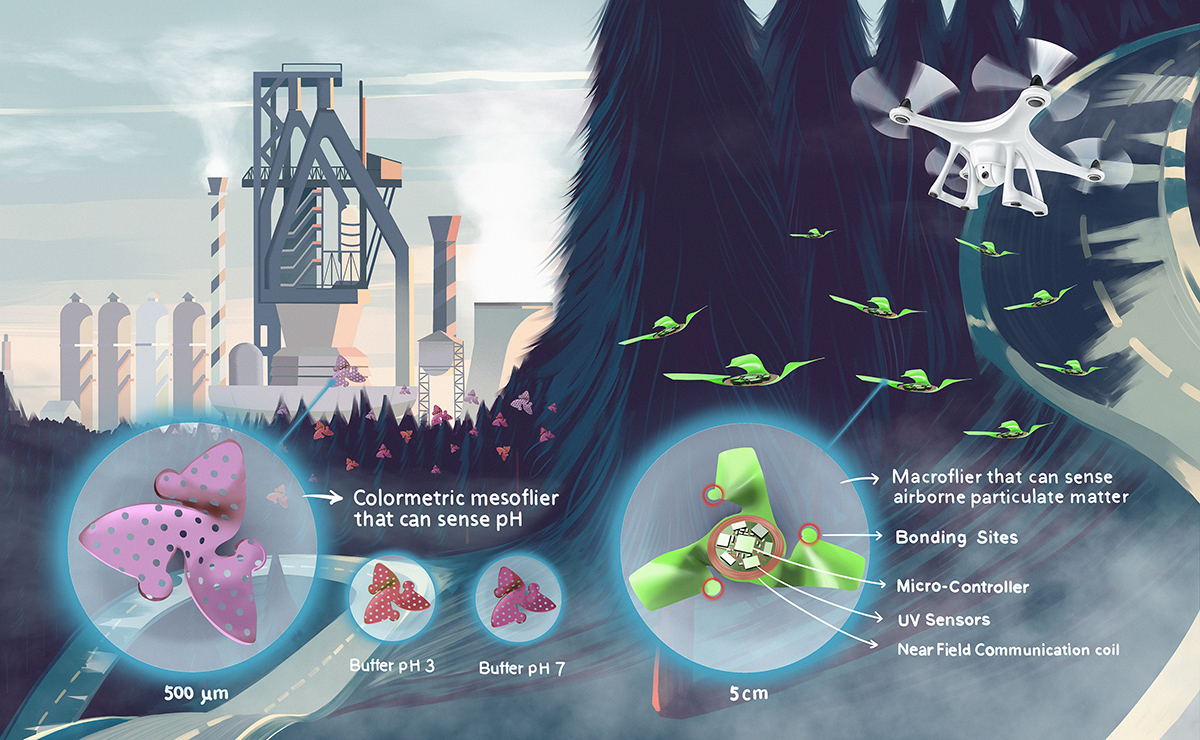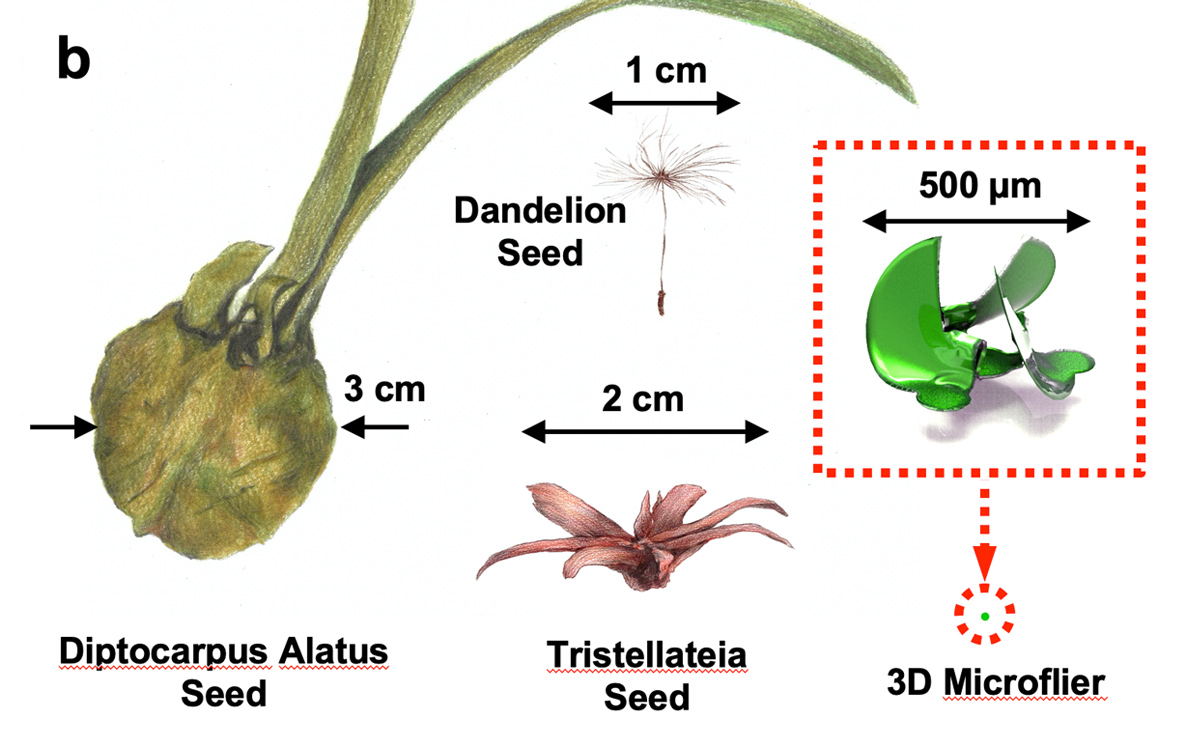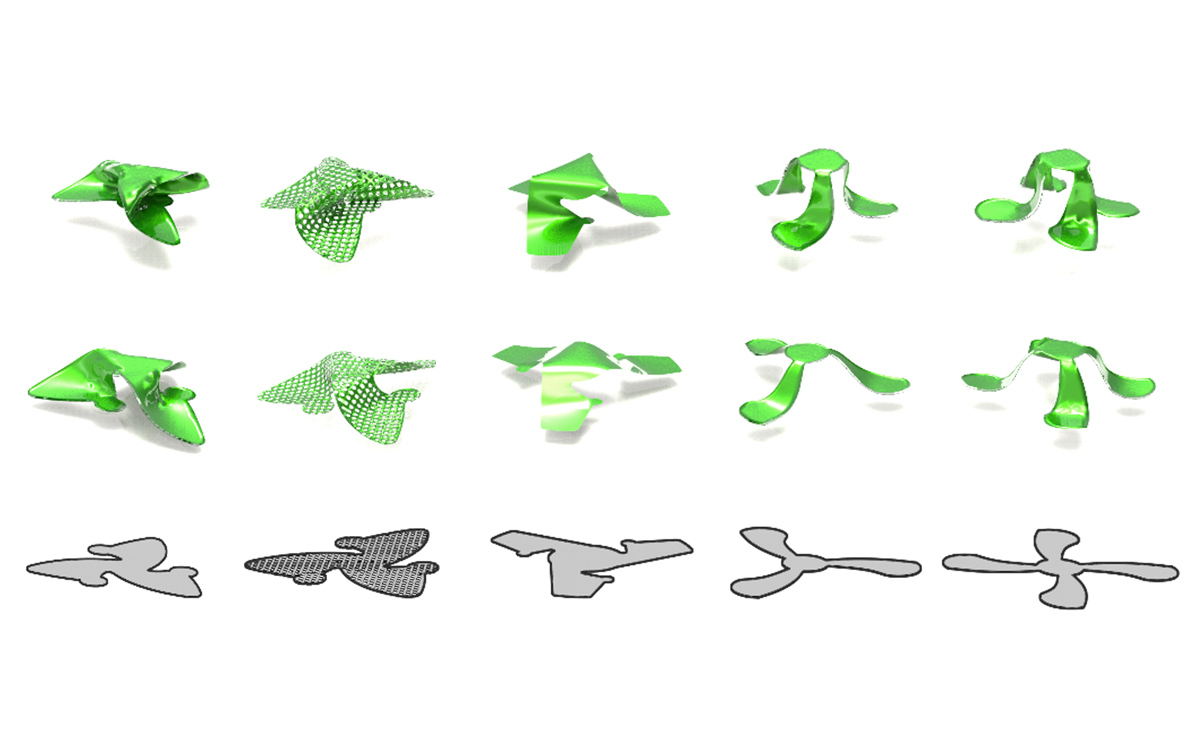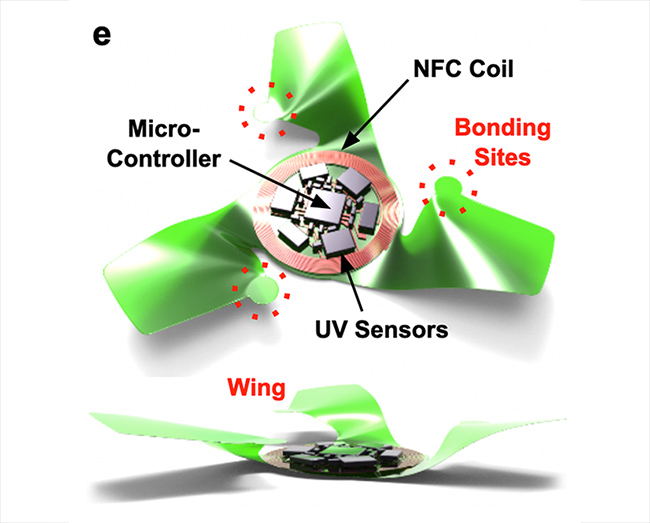Imagine floating fleets of small-scale, low energy fliers that can monitor pathogens or particulate matter in the air.
Seeds have planted new inspiration for scientists who are trying to emulate their ability to travel long distances in freefall.
The geometries of seeds combine high drag forces and significant uplift, relative to the downward force of gravity, which results in the very slow descent speed or ‘terminal velocity’, explains Yihui Zhang, who works within Tsinghua’s Engineering Mechanics Department and Center for Flexible Electronics Technology.
In Nature in September 2021, Zhang and his collaborators described a framework to explore some of the possibilities seed-inspired fliers bring to environmental monitoring. To do so, they created and tested a number of shapes, the most complete version of which was a 5 cm battery-free wireless flier capable of detecting airborne particles.

The researchers modeled a number of fliers with geometries inspired by seeds that were designed to carry out environmental monitoring. These included helicopter style ‘mesofliers’ (usually about 1 mm) with polycarbonate surfaces that respond with different colours based on local pH and ‘macrofliers’ (>1 mm) that use UV sensors to identify airborne particulate matter.
Why are these shapes being examined now? Very small objects tend to have advantages in the aerodynamic behaviour that makes passive ‘flight’ possible, explains Zhang. Recent developments in 3D mesostructure manufacturing and miniaturized electronic, optoelectronic, microfluidic and microelectromechanical technologies make the fabrication of seed-inspired 3D electronic devices practical.
The paper’s authors identified promising forms and fabrication techniques, but they also note the challenges of wind and biodegradability. Nonetheless, Zhang estimates that it could take as little as “three to five years to realize useful environmental monitoring via seed-inspired fliers”.

Shown to scale: the helicopter shaped seeds of Diptocarpus alatus and Tristellateia, a parachute type seed from a dandelion, and a 3D microflier.
Seeds of innovation
There are many potential uses for fliers. Chinese researchers have been working hard to understand the sources of airborne particulate matter from pollution, for instance.
After a series of weather events, exacerbated by pollution, caused widespread health problems across the country in 2013, the Chinese government’s 2013 Air Pollution Action Plan put in place reforms that helped make significant improvements to air quality. Atmospheric particulate matter (PM) 2. 5 levels in Beijing reduced by 33% between 2013 and 2017, for example.
So far, these reductions have come about largely due to stringent regulation of industry, but to understand smaller sources of airborne particulate matter is complex. Plane, drone or weather balloon measurements are limited by the cost implications, while tracking by satellite can only show detail at a resolution down to 3 km. Fliers could provide much more detailed data than stationary ground monitors. This detailed data could also help build algorithms to improve satellite pollution assessments, says Zhang.
Tiny seed-inspired fliers could be deployed by plane or drone, he suggests. “Even releasing the fliers by hand at the ground level is possible, as the fliers can be carried far away by the wind,” he speculates.
Size does matter
In their study, Zhang and his collaborators set out to look specifically at the possibilities of passive structures designed for controlled, unpowered flight across natural environments or city settings.
Seed geometries, they note, fall broadly into four categories: parachutes, gliders, helicopters and flutterers, all of which are of a large area relative to their mass, slowing their descent.
Using theoretical, experimental and computer simulations, the international group determined that helicopter fliers exhibited the most stable falling behaviours. They also noted that small micro-fliers were typically more aerodynamically effective. “But a trade-off is that the small scale microfliers cannot carry large payloads, such as electronic components for targeted missions,” says Zhang. “Therefore, practical applications will need balance terminal velocity and capability to carry payloads.”
The team examined the effect of scale, porosity, number of wings and aspect ratio for helicopter style microfliers (<1 mm), mesofliers (about 1 mm) and macrofliers (>1 mm). “At small scales, shapes composed of fibers, or with porosity, can help create more drag and lower terminal velocity. At relatively larger scales, chiral design and improved blade design such as curved blades can help to reduce terminal velocity,” explains Zhang.
While the team hopes to focus more on IoT enabled fliers, they also looked into an example that used electronic alternatives – pH-responsive 3D mesofliers that use a color indicator based on anthocyanin infiltrated into a polycarbonate membrane. Aerial photographs of these sensors could be analyzed for monitoring purposes.
Other options for non-electrical sensors, says Zhang, include ultraviolet light intensity sensors, temperature/humidity-triggered sensors and chemically driven Volatile Organic Compounds (VOC) gas sensors.

The geometrical transformation of different 2D precursors (bottom row) into corresponding 3D structures with modest (middle row) and large (top row) aspect ratios.
Particulate matter sensing
Polymer films were used to form each of the fliers the group tested via shape material memory effects. Specifically, after etching, heating the assembled flier to 70 °C for one minute in an oven and cooling it to room temperature created the 3D shape. Immersing the structure into chemical solutions to eliminated bonding site layers then helped further release the structures as free-standing objects.
To make their largest test flier, the electronics-carrying particulate matter sensing flier, Zhang and his team layered 12 micrometre shape memory polymer and 18 micrometre copper foils.
The copper foils can serve as reliable metal interconnections for electronic components after wet etching, explains Zhang. Transfer printing the individual components and soldering yielded a wireless sensing system of particulate matter.
This ‘planar-fabrication-based process’ is intrinsically compatible with the well-developed fabrication techniques of conventional silicon-based electronics, Zhang points out.

A 3D IoT macroflier with a circuit to measure fine dust pollution through a light dosimetry method.
Flight path forward
There are other possible uses for the fliers, of particular interest, in disease management. “Some biochemical sensors can sense the metabolites of certain pathogens,” explains Zhang. “In combination with the spatiotemporal monitoring of temperature and humidity, it is possible to judge the spread of pathogens in the air.”
But there are still a number of challenges to be addressed — including how to effectively account for wind. “In future works, dynamic modelling methods will be applied to simulate the flier in wind, and dynamic theoretical models will help to understand the underlying mechanisms,” says Zhang.
This melds into future plans to make the fliers slightly less passive. “For example, we plan to integrate the flier with actuation and control modules so that they can self adjust the tilt angle of their blades to change the flight path, according to local wind strength and direction sensed by the flier,” explains Zhang.
Other commentators have noted that researchers will need to create biodegradable components as the largely passive devices will likely not be easily retrievable. This important advance will take a coordinated international effort and is still some way off, says Zhang.
“As far as I am concerned, it will probably take 10 years to realize fully-degradable integrated smart fliers,” he says. “The connections and the substrates can already be made degradable. But to make the chips also degradable, enormous efforts are still needed.”
Reference
Kim, B.H., Li, K., Kim, JT., Park, Y., Jang, H. et al. Three-dimensional electronic microfliers inspired by wind-dispersed seeds. Nature 597, 503–510 (2021)
doi: 10.1038/s41586-021-03847-y

